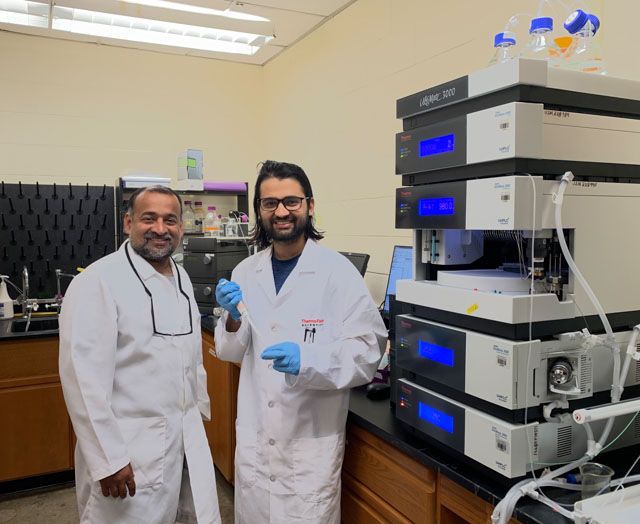USM Professor’s Research on Neurodegenerative Diseases Published in Biophysical Journal
Fri, 06/03/2022 - 08:59am | By: Ivonne Kawas

Pictured from left to Right: Dr. Vijay Rangachari and graduate student Shailendra Dhakal.
Many neurodegenerative diseases such as Alzheimer’s, Parkinson’s disease, amyotrophic lateral sclerosis (ALS) and frontotemporal lobar degeneration (FTLD) have a commonality that they involve “clumping” of proteins as the cause of toxicity in the brain. One such protein called TDP-43, forms clumps in the brain of patients with ALS and FTLD.
ALS and FTLD are neurodegenerative diseases with onset of symptoms usually occurring around 65 years of age. As the name suggests, FTLD affects two distinct frontal and anterior temporal region of the brain resulting in behavior or language impairment. For example, changes in personality, difficulties in remembering specific words and objects thereby impairing the ability to speak and communicate.
On the other hand, ALS, also known as Lou Gehrig’s disease, involves loss of motor neurons that controls the movement. This results in muscle weakness and difficulty in movement, ability to speak, swallow, and sometimes even breathe.
A University of Southern Mississippi (USM) professor’s research paper recently published in the prestigious Biophysical Journal titled, “Charge and Redox States Modulate Granulin–TDP-43 Coacervation Toward Phase Separation or Aggregation,” shows that the nature of TDP-43 clumps can be modulated by another protein called granulin, which are typically produced during inflammation.
Corresponding author, Dr. Vijay Rangachari, Director of the Center for Molecular and Cellular Biosciences and Professor of Biophysical Chemistry, and his research group collaborated with Professor Dr. Sarah Morgan in the School of Polymer science and Engineering on this groundbreaking research.
Dr. Rangachari noted that the results from this research paper uncover the potential for using granulin as biomarkers for the diagnosis of inflammation-induced onset of FTLD. “Granulins are the smaller peptide known to stimulate the production of pro-inflammatory cytokines which is a molecule secreted by different cells that induces inflammation,” said Dr. Rangachari. “Providing the role of inflammation in early stages of neurodegenerative diseases and estimating the level of granulins in the cerebrospinal fluid/blood could serve as potential biomarkers for early diagnosis and therapy of neurodegenerative diseases,” he added.
By demonstrating the potential link between inflammation and the onset of these neurodegenerative disorders, Dr. Rangachari’s research can positively impact diagnostic and therapeutic development and in mitigating disease progression.
“The role of inflammation in neurodegenerative diseases has been shown by many studies,” said Dr. Rangachari. “It has been believed that inflammation plays role in early stages of neurodegeneration than later. Thus, many neuroprotective therapeutic agents can be developed by targeting the early inflammatory processes that may prevent or delay the disease progression.”
The research shows the molecular level of interactions between the granulin and TDP-43, and what intrigued Dr. Rangachari most about it is: “the fact that granulins can modulate the phase-transitions of TDP-43 in such a way that seems intricately dictated by the genetic code of granulin suggesting an evolutionary basis for their interactions.”
Biophysical Journal, a peer-reviewed scientific journal published by Cell Press, publishes research and review articles relating to important biological, chemical, and physical mechanisms.
To learn more about Dr. Rangachari and his research visit his USM faculty profile. To read this paper, visit the Biophysical Journal.